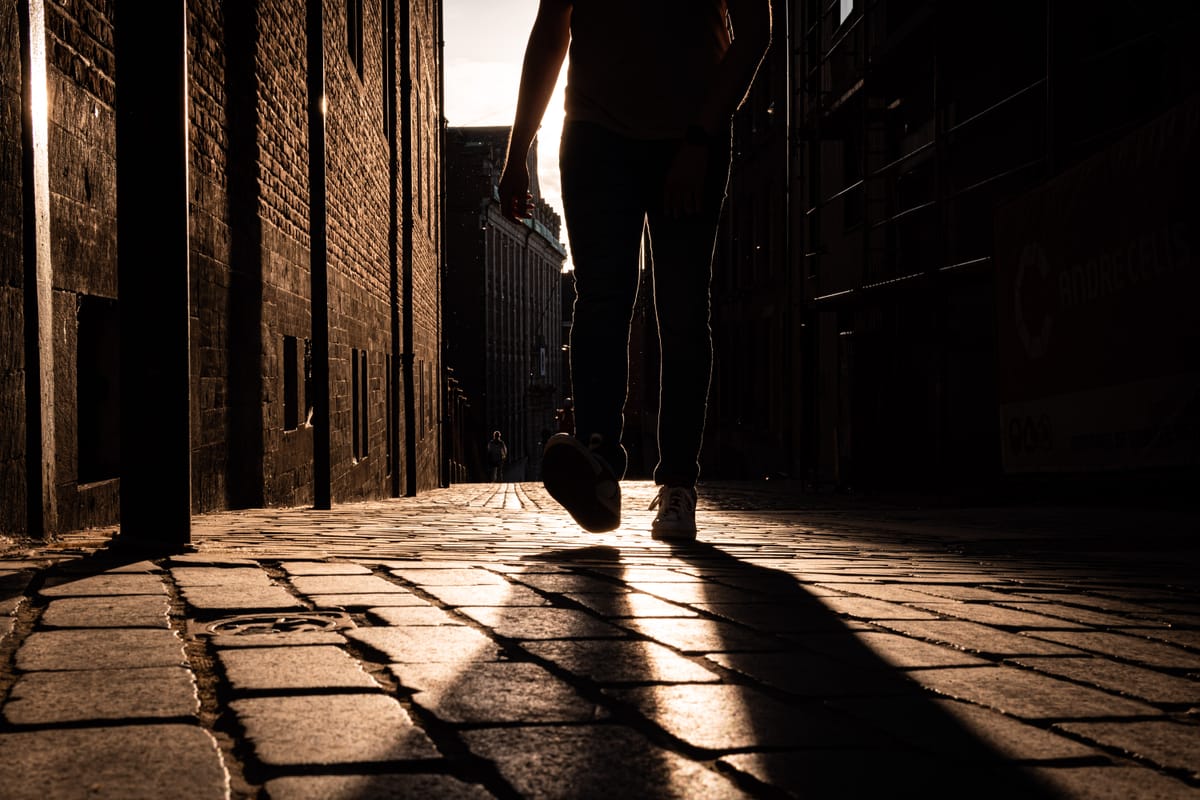Know where you’re going
Practicing taking up space

I always bump into other people. Peacefully walking down the sidewalk, there’s suddenly this other person approaching. Our eyes lock and the mind games begin: ”Will you move to the left? To the right?” And then of course we run into each other.
On top of that, our predictions of where the other person goes next is wrong like 5 more times, so we awkwardly dance around like clumsy pigeons until we move past another. And in my mind, I only hear this begging question of why the fuck this keeps happening to me.
But with some people, it’s different. With them, my body subconsciously steps to the “correct” side long before we meet. No mind games, no bumping, and no begging question. And if at the last moment there’s even a small chance that we could still bump into each other, it’s not their body that moves, but mine. Ouch.
I struggle with taking up space, so I’ve been wondering if I could practice it in a low-stakes environment. So over the last few weeks, I’ve experimented with changing how I walk on sidewalks to see if I could get other people move out of my way.
Three sidewalk styles
As part of this experiment, I’m thinking of three kinds of people based on how they walk:
- The one that always yields (”the dodger”)
- The one that yields but often bumps into others (”the bumper“)
- The one that never yields (”the mover”)
I’m usually a dodger or bumper. And honestly, I don’t like that. While I don’t mind making space for others, I usually feel like I’m making myself too small. I’d love to develop the freedom to fully show up.
So I’m starting with sidewalks. I’ve noticed that when someone seems to know where they’re going, then others can somehow sense this. So that’s how I start, by focusing my whole attention on where I want to go.
The first thing I noticed was that my body held itself differently. I walked with an upright spine and something I’d describe as “purpose”. I also held my head high, and as a result, I imagined my body telling everyone around me, “Beware! This person knows where they’re going!”
And… most people yielded and made space! I became a mover! After changing something small about myself, my body changed the way it moved. And in turn, the world around me changed, too. I’ve felt a sense of power when I discovered this, realizing that a single thought made other people react differently to me.
At the same time, playing this game was unbelievably exhausting. It doesn’t come naturally. I had to concentrate a lot, and there was also a lingering fear of what might happen if this didn’t work. Not to mention what other people were thinking about this idiot taking up their space.
The best sidewalk style
But is being a mover the best way to move on the sidewalk? Because being a yielder can’t possibly be nice, right? After all, it’s an expression of insecurity, so maybe others see you as weak.
Taking up space isn’t bad. To quote Jacob Collier, one of my favorite musicians: “There’s a myth about if you make yourself too big, then there’s less space for others. It’s not true. The bigger and more comfortable you feel, the bigger and more comfortable everyone else feels around you.”
While I generally agree, you also need to have awareness for other people. Otherwise, you’re like a drummer who only plays loud drum fills (i.e., takes up space). And since they can’t hear anyone else, they actively make others feel small.
I actually think there’s power in yielding. Because you can yield from a place of kindness and courteousness, or simply because you don’t want to go where others are going. At the same time, the desire to be a mover could come from a shadowy place of arrogance or the desire to dominate. That’s not necessarily a bad thing, but definitely something to be aware of.
In German we have an idiom: “Der Klügere gibt nach.” It translates to something like “The wiser one yields.” However, the German version carries a subtle irony: while it praises the wisdom of yielding in conflict, it also implies that always yielding lets the foolish rule.
So, I don’t think there’s one best way to move on the sidewalk – or in life, for that matter. But I’m certain I don’t want to live in a world of only movers, only yielders, or only bumpers. It would be an antagonistic place with lots of potential for conflict, or one with too much avoidance, or too much struggling. I’d rather live in a world where everyone has the internal freedom to decide who they want to be.
Freedom to choose
Because in the end, I believe this sidewalk exercise is about freedom. The freedom to consciously choose to yield or to dodge, to be the “wise one”. To move around, through, or into.
I sometimes observe this freedom during contact improvisation, a kind of dance. On the days when I have that freedom, I’m both a mover and a yielder, as well as a bumper. I’m not afraid of taking up space, and I enjoy making space for others, or bumping into them. Movement turns into play.
“Taking up space” implies that space is limited and that claiming it is a zero-sum game. Which necessarily makes it something to fight for, something assertive or even aggressive. But I don’t think this is always the right way to think about it, because who defines what the space even is? And who says that it can only be occupied by one person?
Instead of talking about "taking up" space, how about thinking of it as "dancing with" space?